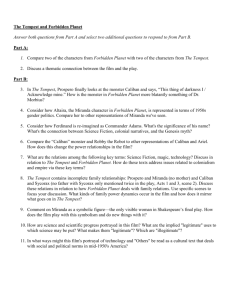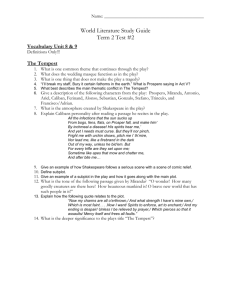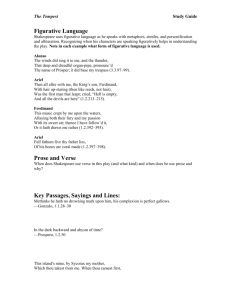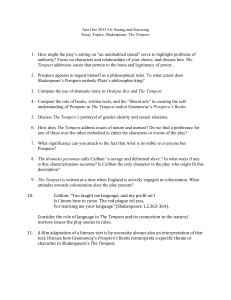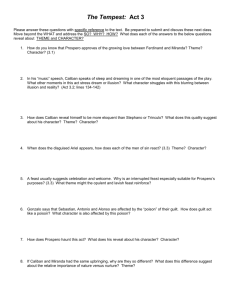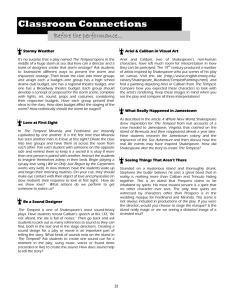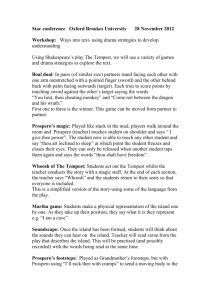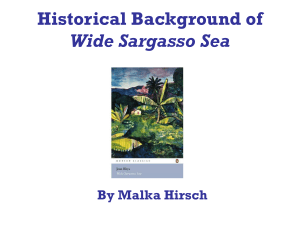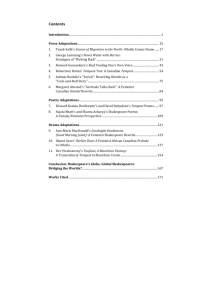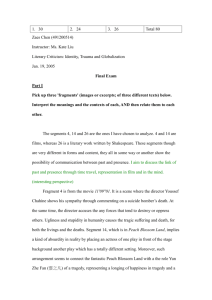Positioning Jean Rhys''s Wide Sargasso Sea in her Contemporary
advertisement
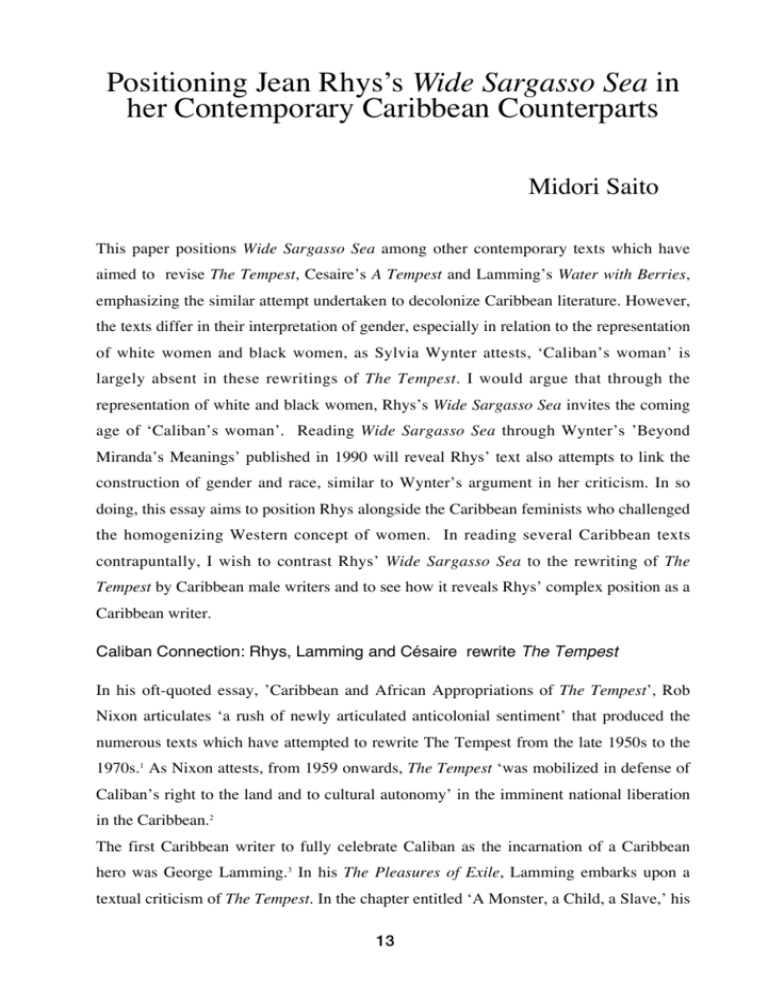
Positioning Jean Rhys’s Wide Sargasso Sea in her Contemporary Caribbean Counterparts Midori Saito This paper positions Wide Sargasso Sea among other contemporary texts which have aimed to revise The Tempest, Cesaire’s A Tempest and Lamming’s Water with Berries, emphasizing the similar attempt undertaken to decolonize Caribbean literature. However, the texts differ in their interpretation of gender, especially in relation to the representation of white women and black women, as Sylvia Wynter attests, ‘Caliban’s woman’ is largely absent in these rewritings of The Tempest. I would argue that through the representation of white and black women, Rhys’s Wide Sargasso Sea invites the coming age of ‘Caliban’s woman’. Reading Wide Sargasso Sea through Wynter’s ’Beyond Miranda’s Meanings’ published in 1990 will reveal Rhys’ text also attempts to link the construction of gender and race, similar to Wynter’s argument in her criticism. In so doing, this essay aims to position Rhys alongside the Caribbean feminists who challenged the homogenizing Western concept of women. In reading several Caribbean texts contrapuntally, I wish to contrast Rhys’ Wide Sargasso Sea to the rewriting of The Tempest by Caribbean male writers and to see how it reveals Rhys’ complex position as a Caribbean writer. Caliban Connection: Rhys, Lamming and Césaire rewrite The Tempest In his oft-quoted essay, ’Caribbean and African Appropriations of The Tempest’, Rob Nixon articulates ‘a rush of newly articulated anticolonial sentiment’ that produced the numerous texts which have attempted to rewrite The Tempest from the late 1950s to the 1970s.1 As Nixon attests, from 1959 onwards, The Tempest ‘was mobilized in defense of Caliban’s right to the land and to cultural autonomy’ in the imminent national liberation in the Caribbean.2 The first Caribbean writer to fully celebrate Caliban as the incarnation of a Caribbean hero was George Lamming.3 In his The Pleasures of Exile, Lamming embarks upon a textual criticism of The Tempest. In the chapter entitled ‘A Monster, a Child, a Slave,’ his 13 anticolonialist reading of The Tempest, Lamming claims the island back from the hands of Prospero. Lamming dwells on two issues: the language and the similarity between Caliban and Miranda. For Lamming, Caliban specifically symbolizes the intellectuals in the Caribbean, marginalized and ostracized from the majority of the people by their colonial education.4 Eleven years later, Lamming returns to the question of Caliban in The Pleasure of Exile and embarks upon a full rewriting of The Tempest in his Water with Berries, published in 1970. The story is about three Calibans who fled the fictious island of San Cristobal to England: Teeton, Roger, and Derek, who are members of the ‘secret gathering’, a group aiming to overthrow the government in San Cristobal. After their imprisonment, they have to leave the island for England. As Caliban represented the Caribbean intellectuals in The Pleasures of Exile, these three represent the Caribbean artists and intellectuals who fled to England: Teeton is a painter, Roger is a composer, and Derek is an actor. Yet, their careers are at a dead end: Teeton is dependent upon the Old Dowager or Mrs. Gore-Brittain, Roger is copying scores, and Derek is playing a corpse and thereby reduced to being a mute. In so doing, Lamming reverses the situation in The Tempest by taking Caliban into Prospero’s country which allows him to depict the ambivalence of these artists ‘caught between the two worlds’.5 Through this depiction of the relation between Teeton and his landlady, Mrs. Gore-Brittain (Old Dowager), Lamming also explores Mannoni’s dependency complex. Teeton considers Old Dowager as a surrogate mother, but ends up killing her. The killing of Old Dowager is inevitable, as she seems to incarnate Britain and Prospero.6 On the other hand, Teeton is attracted to Myra, a prostitute and a daughter of the Old Dowager. Teeton’s attraction and identification with her is further evidence of Lamming’s attempt to link Caliban and Miranda. Also, the linking of Caliban and Miranda is represented in Teeton’s wife, Randa, who sacrifices herself by sleeping with the American ambassador to save Teeton, and commits suicide when Teeton abandons her and leaves San Cristobal. As Lamming linked Miranda and Caliban, Rhys’s Wide Sargasso Sea links Caliban and Miranda. Antoinette in Wide Sargasso Sea, may be considered as Miranda, a meek white creole, propagating colonialist narrative. Yet, in Caliban in Exile, a critic, Margaret Paul Joseph considers Antoinette as Caliban, in line with characters in George Lamming and Sam Selvon’s novels. Joseph claims that the transformation of Antoinette from ‘Miranda’ to ‘Caliban’ occurs when Rochester imitates colonial structure in their relationship, especially when he starts calling his wife Bertha, as if to repeat the act of 14 Prospero giving Caliban his name, thus claiming Caliban as his property. In this respect, the final sequence in which Antoinette is carrying a candle at Thornfield Hall is a reenactment of the slave’s burning of the Coulibri estate, and a final identification of Antoinette with Tia.7 Empowerment of Caliban and the reversal of the role of oppressor/oppressed unite Wide Sargasso Sea and Aimé Césaire’s A Tempest. Contemporaneous to Lamming’s appropriation of The Tempest, Aimé Césaire rewrote the play as A Tempest (Une Tempet) in 1969. In Cesaire’s appropriation, Prospero becomes a colonizer, Caliban a black slave, and Aerial a mulatto. The play reflects the 1960s black nationalism, as shown through the greeting employed between Caliban and Ariel, ‘Uhuru’, a Swahili word meaning ‘independence’.8 Further, Caliban refuses to be called by his name, and demands that Prospero call him X. 9 He highlights the significance of the naming process in colonization by refusing to be named, and thus what it symbolizes. Rob Nixon considers Cesaire’s play as ‘a revolutionary manifesto’ refusing the colonial plot of The Tempest.10 In the play, Caliban is given more importance than Prospero, so as to prove the Hegelian dialectic that the slave is more important than the master.11 At the end of the play, Prospero does not leave the island and is incarcerated within his relation to Caliban. In contrast to Prospero, who degenerate into madness, Caliban celebrates his victory and claims back his island. Unlike Césaire’s A Tempest, Rhys’s Wide Sargasso Sea is not an explicit reversal of the colonial text. Yet, similar to Césaire, Rhys explores the power of naming. Antoinette is called ‘Dudou’ and ‘Marionetta’ before her name was changed to Bertha. Christophine Doubois’s other name is Josephine Dubois, or Pheena, as later Mr. Rochester calls her. In contrast to the various names given to Antoinette and Christophine, Mr. Rochester’s name is not mentioned in the text. By not mentioning Mr. Rochester in the text, Rhys seems to reveal the nature of authority associated with the naming process: In contrast to Caliban who claims to be called X in Césaire’s A Tempest, Rhys, by refusing to name Rochester, demonstrates the power that Rochester exercises in the text. In other words, like the explorers or the colonials who named the flora, fauna and lands of the New World, naming signifies the power that Rochester has. Rochester can name Antoinette or Christophine as his conquest, but the opposite does not take place in the text. This is evident when Rhys connects colonial oppression with gender oppression through the relationship between Rochester and Antoinette. 15 Difference in Representing Women George Lamming and Césaire seem to repeat the masculinist plot of the original text in their rewriting of The Tempest. In other words, they seem to overlook the issues of gender, and mute ‘Caliban’s woman’. I would argue that their rewritings of The Tempest are linked to the larger project of Caribbean nationalism in which European masculinist tradition was repeated, silencing Caribbean women’s voices. In Lamming’s case, there is a certain note of sexual anxiety and ambivalence towards the treatment of gender in his Water with Berries.12 Firstly, ‘the secret gathering’ is a male enterprise while female characters are subjected to violent oppression. As Caliban revolted against Prospero, Teeton eventually kills Mrs. Gore-Brittain.13 Roger’s American wife hangs herself as Roger asks her to abort their mixed race baby. Derek rapes an actress on the stage in a moment of hallucination. The reincarnation of Miranda, as Teeton’s wife Randa, and Myra, both go through the abjection: the former by suicide, the latter by violent rape. In contrast to their troubled relationship with women, the bonding between Teeton, Roger, Derek is not challenged in Lamming’s novel. In rewriting the heroic revolt, Lamming does not confer upon women the will to rebel. This confirms Lamming’s statement in The Pleasure of Exile: ‘resistance and liberation are an exclusively male enterprise’.14 His rewriting of The Tempest evolves around the relationship between Caliban and Prospero, and the gender politics which situate women as objects of exchange is not questioned. Unlike Rhys’ texts or Caribbean women writers’ texts, Lamming’s rewriting is another evidence of early Caribbean literature which revises little about gender politics underlying colonialism. In contrast, Césaire’s A Tempest places much emphasis on Sycorax, transforming it into an omnipresent spirit of ‘mother’ earth.15 However, although Sycorax plays an important role in Césaire’s play, her presence is turned into a somewhat abstract form. By transforming Sycorax into mother nature, nature is ‘made’ feminine, in line with Césaire’s literary tendency since his Notebook on Return to My Native Land. As for the presentation of Miranda, Césaire, unlike Lamming, simply repeats the original plot and reduces her to an object of exchange between men. The link between subordination of women and misogyny with the project of enlightenment and colonialism is never questioned in his rewriting. Despite the fact that the play reverses the position between the European and the non-European race of the original text, the position of women 16 remains static. I would argue that exploration of gender politics in these male writers’ rewritings of The Tempest positions Wide Sargasso Sea significantly apart. In this respect, what Wynter illuminates in her analysis of The Tempest in ‘Beyond Miranda’s Meanings’ and Wide Sargasso Sea, can be linked through the problem of sexuality in colonialism, as well as their attempt to revise the homogenizing concept of ‘women’ from the Caribbean women’s point of view. Wynter’s ‘Beyond Miranda’s Meanings’ investigates the absence of the black Caribbean women in The Tempest. For Wynter, The Tempest represents the order of Western ideology after the Western conquest of the New World. Wynter considers Miranda in The Tempest to represent the white women, while Caliban represents the nonEuropean race. The text places Caliban as subordinate to Miranda, hence, The Tempest reinscribes and replaces gender difference with racial difference.16 As Wynter argues, the hierarchical order in The Tempest makes Miranda the object of desire and Caliban’s woman has to be absent in order to propagate the Western belief of racial superiority; thus making Caliban desire a woman of colour cancels the legitimization of Western global expansion.17 Through Miranda, Wynter criticizes the western feminism exemplified by Luce Irigaray, stating that it dehistorisizes women into one homogenized entity.18 In so doing, Wynter underlines, as Jonathan Goldberg points out, ‘the complicities of white feminism with male and colonial dominance’ and calls for a new definition of woman, ‘located beyond the normative of gender that place Miranda as the endpoint of male desire’.19 Wynter declares Caribbean women can write from both within and without Western thought and its system of meanings, in other words, from the ‘demonic ground’, articulating the new ground – the issue of race and gender – in Western feminism. Wynter’s criticism can be read against the major Caribbean novels written by male writers which reinscribe the Western and Humanist plot that positions Man at its top of the hierarchy. In other words, the rewriting of The Tempest that I have discussed above, reproduces the binary opposition of man and woman in attempt to underline the distinction between black and white, without questioning how such a gender category becomes a racial category. In this respect, Wynter’s insight into the link between gender and race, and “othering” of non-Western women might be related to Rhys’ attempt in Wide Sargasso Sea, since they are both concerned with the positioning of non-Western 17 women within the Western canon. More boldly speaking, I argue that both of them attempt to highlight the interconnectedness between the category of gender and race. Choosing to situate Rhys as a Caribbean womanist like Wynter is an indubitably debatable issue, since Rhys has herself expressed her indifference to feminism. Yet Rhys’ indifference to feminism can be linked to many black female novelists who did not ally themselves with feminism which does not allow for the consideration of being a nonWestern woman. The difference in position of non-Western women with regard to feminism can be illustrated through their reaction to Jane Eyre. For Instance, Okonjo Ogunyemi argues that Jane Eyre is ‘not just a feminist novel, but disarmingly realistic appraisal of white survival ethics’ for a black reader.20 Ogunyemi argues that Brontë allows Bertha to be ‘betrayed on all sides by white women’ hence creating ‘a tragic vision of feminism for a black reader’.21 She argues that the novel is another instance of white dominated feminism, hence the reason many black women novelists failed to identify themselves with Jane Eyre as a novel of women’s liberation.22 In this respect, the protagonist of Wide Sargasso Sea, Antoinette, is the Other of white feminism, as well as the Other and inferior to the English. By writing from the category outside of white Western women, Rhys also investigates the possible link between the binaries of gender and race in her exploration of the marginalisation of non European Western creole women. Similar to Wynter’s attempted criticism, I argue that the novel is Rhys’ response to the homogenising concept of ‘Woman’, represented by Jane Eyre. The novel ends with a dream that reminds Antoinette of her mission. The long lost friend, Tia, reappears in the last dream. The last name that Antoinette utters in her dream is Tia’s.23 However, in reading the final dream scene, Edward Brathwaite states that the friendship between the white creole and the black creole is impossible: The ‘jump’ here is a jump of death; so that Antoinette wakes to death, not to life; for life would have meant dreaming in the reality of madness in a cold castle in England. But death was also her allegiance to the carefully detailed exotic fantasy of the West Indies. In fact, neither world is ’real’. they exist inside the head. Tia was not and never could have been her friend. No matter what Jean Rhys might have made Antoinette think, Tia was historically separated from her by this kind of paralogue.24 18 Indeed, the stories of black creole is largely written out in Wide Sargasso Sea, and the friendship between Antoinette and Tia may be impossible, but I argue that it is Rhys’ deliberate strategy to leave the stories of black creole untold since she was fully aware of their capacity of telling their own stories. The final dream scene, the unsettling of the clear border between dream and reality, the past and present, seems to be an attempt to erode the boundary between the white creole and the black creole, otherwise impossible in the divided reality. Antoinette’s mission, the ultimate suicide in Jane Eyre, appears to be the only way for her to take responsibility for the haunted past as a descendant of the white plantocracy. Perhaps, as Brathwaite states, Antoinette’s life meant ‘dreaming in the reality of madness’. Or perhaps, Antoinette’s dream was also Rhys’ dream. A dream of the girl who longed to be ‘black’, longed to dance in the Carnival, yet instead had to watch the procession from the open window, ‘sitting stiff and well behaved’.25 It may also have been a dream of a girl who, confronted by hatred, failed to become friends with any of ‘the coloured girls’ at the convent.26 If the writing is the only place that the writer can truly reside, it might be possible to say that Rhys attempted to return, through Antoinette’s sacrifice and redemption, to the place of reconciliation that she did find in real life. Throughout her life, Rhys’ chief concern was the West Indies, and she read many Caribbean writers.27 Written at the time of the Notting Hill riot in London and the Caribbean Artists’ Movement, the ending of Wide Sargasso Sea appears to be a distant call to her Caribbean sisters. The friendship between Tia and Antoinette may only be possible in the reality of madness, as Brathwaite claims, but it is a dream for the possibility of impossibility. In this way, Rhys’ rewriting is linked to what Wynter calls Caribbean women’s characteristic of writing from the demonic ground, writing from the impossible position. Antoinette’s leap to rejoin Tia is Antoinette’s final acknowledgment of the sins of slavery that separated her from Tia. Escaping from Rochester calling her ‘Bertha’, Antoinette finds herself as ’Antoinette’, a name marginalized in the text of Jane Eyre. In so doing, Rhys seems to liberate the Caribbean subject of Antoinette/Tia from that of Jane/Bertha, thus refusing to be the other of Jane. The reunion is only possible through Antoinette’s death, yet it is a positive affirmation of the end of plantocracy and the 19 liberation from the static identity that categorizes Antoinette as white. In the final scene in which she leaps towards her death, Antoinette, once Miranda, now becomes Caliban, calling her/his mate, Tia, beyond Miranda’s meanings. Notes 1 2 3 4 5 6 7 8 9 10 11 12 13 14 15 16 17 18 19 20 21 22 23 24 25 Nixon, Rob. ‘Caribbean and African Appropriations of The Tempest,’ Critical Inquiry, 13: 3 (Spring 1987), pp.557-578, p.557. ibid., p.566. ibid., p.566. ibid., p.568. Joseph, Margaret Paul. Caliban in Exile: the Outsider in Caribbean Fiction. Westport: Greenwood Press, 1992, p. 53. Goldberg, Jonathan. Tempest in the Caribbean. Minneapolis; London: University of Minnesota Press, 2004, p.32. Joseph, ibid., p.46. Goldberg, ibid., p.93. Nixon, ibid., p.568. Goldberg, ibid., p.94. Goldberg, ibid., p.100. Hulme, Peter. ‘Reading from Elsewhere: George Lamming and the Paradox of Exile,’ Peter Hulme and William H. Sherman eds., The Tempest and its Travels. London: Reaktion, 2000, p.232. Lamming, George. Water with Berries. London: Longman, 1971, p.246. Lamming, George. The Pleasure of Exile. Annn Arbour: University Michigan Press, 1992, p.18. Césaire, Aimé. A Tempest. Richard Miller translated. New York, TCG Translations, 2002, p.18. Goldberg, ibid., pp.68-70. Wynter, Sylvia. “Beyond Miranda’s Meanings: un/silencing the ‘Demonic Ground of Caliban’s Woman.” Out of Kumbla: Caribbean Women and Literature. Eds. Carole Boyce Davies and Elaine Savory Fido. Trenton, NJ: Africa World Press, 1990. 355-366, p.362. Wynter, ibid., p.363. Goldberg, ibid., pp.68-70. Ogunyemi, Chikweyne. ‘Womanism: The Dynamics of the Contemporary Black Female Novel in English,’ Signs, Vol. 11, No.1. (Autumn, 1985), pp. 63-80, p.65. Ogunyemi, ibid., p.65. Ogunyemi, ibid., p.65. Rhys, Jean. Wide Sargasso Sea, with background critcism, edited by Judith L. Raiskin, W.W. Norton, New York, London, 1999, p.112. Brathwaite, Edward. Contradictory Omens. Mona: Savacou Publications, 1974, p.36. Rhys, Jean. Smile Please: an unfinished autobiography, Penguin, London, New York 1979, p.52. 20 26 Rhys, Jean. Smile Please, p.49. 27 Gregg, Veronica Marie. Jean Rhys’s Historical Imagination: Reading and Writing the Creole, Chapel Hill: University of North Carolina Press, 1995., p.2. Works Cited Brathwaite, Edward. Contradictory Omens. Mona: Savacou Publications, 1974. Césaire, Aimé. A Tempest. Richard Miller translated. New York, TCG Translations, 2002. Goldberg, Jonathan. Tempest in the Caribbean. Minneapolis; London: University of Minnesota Press, 2004. Gregg, Veronica Marie. Jean Rhys’s Historical Imagination: Reading and Writing the Creole, Chapel Hill: University of North Carolina Press, 1995. Hulme, Peter. ’Reading from Elsewhere: George Lamming and the Paradox of Exile,’ Peter Hulme and William H. Sherman eds., The Tempest and its Travels. London: Reaktion, 2000. Joseph, Margaret Paul. Caliban in Exile: the Outsider in Caribbean Fiction. Westport: Greenwood Press, 1992. Lamming, George. The Pleasure of Exile. Annn Arbour: University Michigan Press, 1992. _____. Water with Berries. London: Longman, 1971. Nixon, Rob. ‘Caribbean and African Appropriations of The Tempest,’ Critical Inquiry, 13: 3 (Spring 1987), pp.557-578. Rhys, Jean. Letters 1931- 1966: selected and edited by Francis Wyndham and Diana Melly, Penguin, London, New York 1985. _____. Smile Please: an unfinished autobiography, Penguin, London, New York 1979. _____. Wide Sargasso Sea, with background critcism, edited by Judith L. Raiskin, W.W. Norton, New York, London, 1999. Ogunyemi, Chikweyne. ‘Womanism: The Dynamics of the Contemporary Black Female Novel in English,’ Signs, Vol. 11, No.1. (Autumn, 1985), pp. 63-80. Wynter, Sylvia. “Beyond Miranda’s Meanings: un/silencing the ‘Demonic Ground of Caliban’s Woman.” Out of Kumbla: Caribbean Women and Literature. Eds. Carole Boyce Davies and Elaine Savory Fido. Trenton, NJ: Africa World Press, 1990. 355-366. 21
